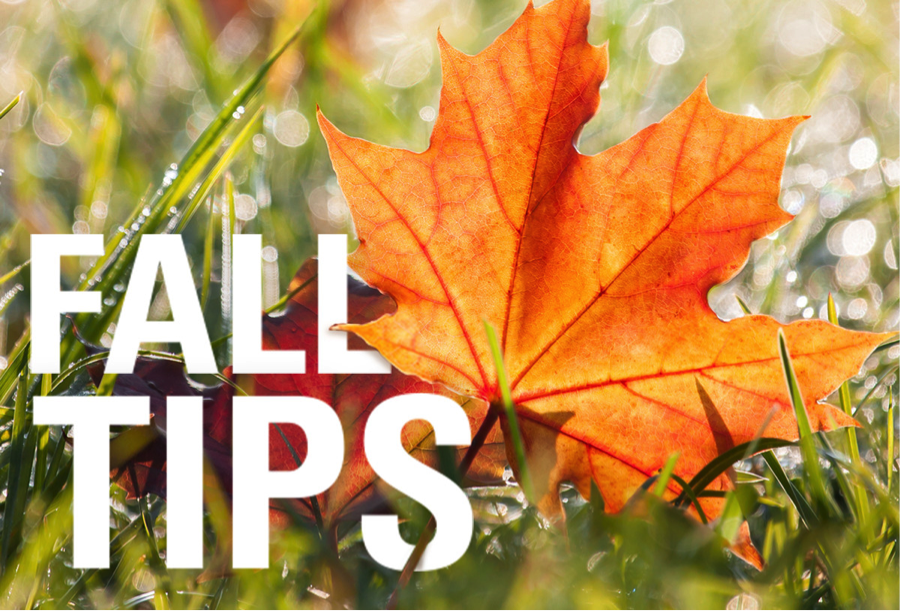Lawn Care & Yard Maintenance to Prepare for Cooler Weather
Fall means cooler temperatures, so it is necessary for you to care for your lawn appropriately. Here are several tips to help you prep your lawn for colder days and answer questions you may have about how to do it.
6 Tips for Fall Lawn Care and Maintenance
Tip 1 | Watering Schedule: Learn when and how to water your lawn in autumn
When caring for your lawn, keep in mind that it needs less water than you think. People tend to irrigate too often. Most lawns only need to be watered once every 4 to 8 days. Grass needs about one inch of water per week, and it needs to be applied evenly and deeply throughout the lawn. How long depends on your irrigation system, but avoid watering in the evening as this promotes fungal diseases. Water your lawn preferably in the early morning to avoid evaporation.
Tip 2 | Fertilization: Find out how often to fertilize your lawn this fall
Fall is the best time to fertilize your lawn. Based on the nitrogen concentration of your lawn, you will need to calculate how much fertilizer you will need. Keep in mind that it is better to use too little fertilizer than too much. Cool-season and warm-season grasses have different fertilizing schedules, but as a rule of thumb you’ll want to make two applications: one in September/October and the next in November. Follow the manufacturer’s recommendations regarding the rate of application and make sure you apply your fertilizer evenly. Use a different fertilizer formula for the second application.
Tip 3 | Weed Control: Learn how to prevent weeds from invading your lawn
Weeds such as dandelions, thistles, clover and weed grasses are one of the most common lawn problems. Large numbers of weeds are normally an indication of a lawn suffering from poor nutrient levels. Fertilizer is the ideal solution in such cases. Frequent mowing at a high cutting height acts as an additional defense against the growth of weeds by preventing access to the light needed for germination. Using good-quality seed is also a factor that should not be overlooked. In addition, carrying out regular and deep scarifying is an effective method of preventing weeds from invading in the first place. However, digging weeds out which have taken hold remains the best and often only solution.
Tip 4 | Drought Repair: Learn how to care for your lawn after a drought
If drought persists into the fall, you’ll want to water your lawn a couple times a week long enough to soak the soil several inches deep. To take care of your lawn, aerate it from time to time and when you water it, make sure to do it slowly and with some kind of sprinkler system or hose. Do the same for your plants, but the best thing you can do to protect your plants and flowers during drought conditions is actually to use mulch. Lastly, during hot and dry conditions, it is a good idea to conserve water in any way possible, so see our full list of lawn drought tips for more details.
Tip 5 | Lawn or Soil Aeration: Give your lawn a breather
Before starting the lawn aeration process, cut your lawn short and water it (but don’t flood it) until you can easily push your index finger roughly one inch into the ground. If the ground is hard, the aerator won’t be able to penetrate the soil and the seed will not have the holes in the ground and loose soil it needs to germinate, root and establish. For best results, make multiple passes with the aerator to avoid inconsistent grass growth with noticeable stand-alone patches of grass. If your lawn is in good shape, two passes is sufficient. If your lawn has large bare areas, make three to four passes.
Tip 6 | Leaf Removal: Clear leaves off your lawn with a blower
If you want a real workout, use a manual rake. But if you want to get extra clearing power turn to a leaf blower or shredder vac. Powered blowers and shredder vacs relieve the strain of clearing driveways, paths and lawns, and the latest STIHL models make clearing leaves a breeze. Blow leaves into a pile before collecting them up with a STIHL shredder vac or by hand. Mowing over leaves is one of the quickest and easiest ways to clear them from your lawn. Your lawn mower must have good suction power and be a collecting model (with a box or bag.)
These tips should help you take care of your lawn this season, but if you want more details regarding how to complete your DIY and lawn care projects with ease this fall, take a look at our Fall Project Guides.
Sourced from STIHL USA
